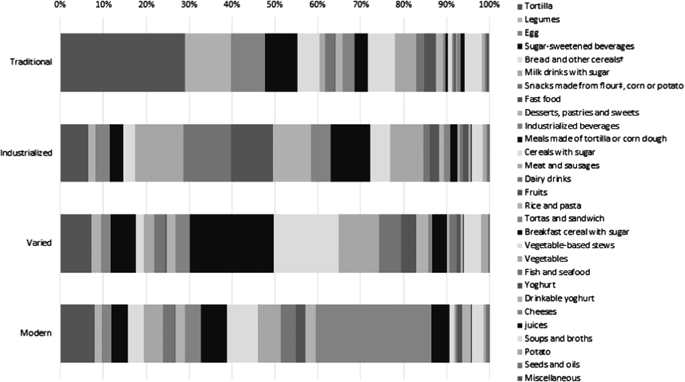European Journal of Clinical Nutrition ( IF 3.6 ) Pub Date : 2020-03-09 , DOI: 10.1038/s41430-020-0598-3 Claudia Gabriela García-Chávez 1 , Juan A Rivera 2 , Eric Monterrubio-Flores 1 , Sonia Rodríguez-Ramírez 1

|
Background
The prevalence of overweight and obesity in Mexican schoolchildren has increased in the past three decades. Dietary pattern approaches to assess diet have been used to study the relation between nutrition and chronic conditions.
Objective
The objective of this study is to analyze the association between dietary patterns (DP) and overweight and obesity in Mexican schoolchildren.
Methods
We analyzed information from schoolchildren who participated in the National Health and Nutrition Survey 2012 (ENSANUT-2012). Dietary information was obtained through a 24-h recall of 2751 children (5–11 year). Foods were classified into 33 groups, and the DPs were identified by cluster analysis (k-means method). Weight and height were measured to estimate the body mass index (BMI), by classifying overweight if the Z score was >1 and ≤2 standard deviations (SD), and obesity when the Z score was >2SD. To analyze the association, a Poisson regression model was used, adjusting by age, region, area of residence, socioeconomic status (SES), and the survey design.
Results
Four DPs were identified: “Traditional”, “Industrialized”, “Varied”, and “Modern”. The “Modern” DP was associated with obesity (PR = 1.7) (p < 0.05) compared with the “Traditional” DP.
Conclusions
The “Modern” DP could be influencing the development of obesity in Mexican schoolchildren. The promotion of healthy food and public health strategies to those food groups that should be discouraged are necessary to reverse the obesity epidemic in Mexican children.
中文翻译:

饮食模式与墨西哥学童肥胖有关。
背景
在过去的三十年中,墨西哥学童中超重和肥胖的患病率有所增加。饮食模式评估饮食已被用于研究营养与慢性病之间的关系。
目的
这项研究的目的是分析墨西哥学龄儿童的饮食习惯(DP)与超重和肥胖之间的关系。
方法
我们分析了参加2012年国家健康与营养调查(ENSANUT-2012)的学童的信息。通过对2751名儿童(5-11岁)进行24小时召回来获得饮食信息。将食物分为33组,并通过聚类分析(k均值方法)确定DP。通过测量体重和身高来估计体重指数(BMI),如果Z得分> 1和≤2标准差(SD),则将超重分类;如果Z得分> 2SD ,则将肥胖归类。为了分析这种关联,使用了Poisson回归模型,并根据年龄,地区,居住地区,社会经济地位(SES)和调查设计进行了调整。
结果
确定了四个DP:“传统”,“工业化”,“变体”和“现代”。 与“传统” DP相比,“现代” DP与肥胖相关(PR = 1.7)(p <0.05)。
结论
“现代” DP可能会影响墨西哥学童肥胖的发展。为避免墨西哥儿童中的肥胖病流行,有必要向那些应劝阻的食物群推广健康食品和公共卫生策略。











































 京公网安备 11010802027423号
京公网安备 11010802027423号